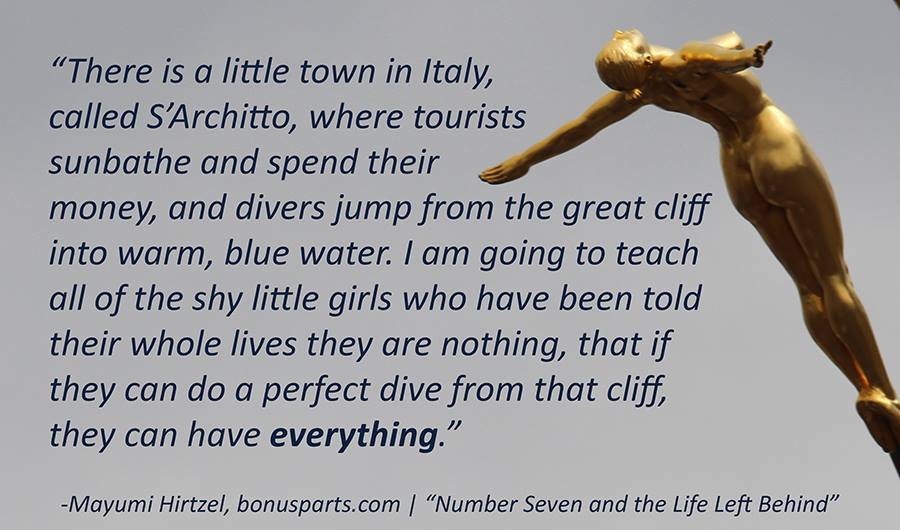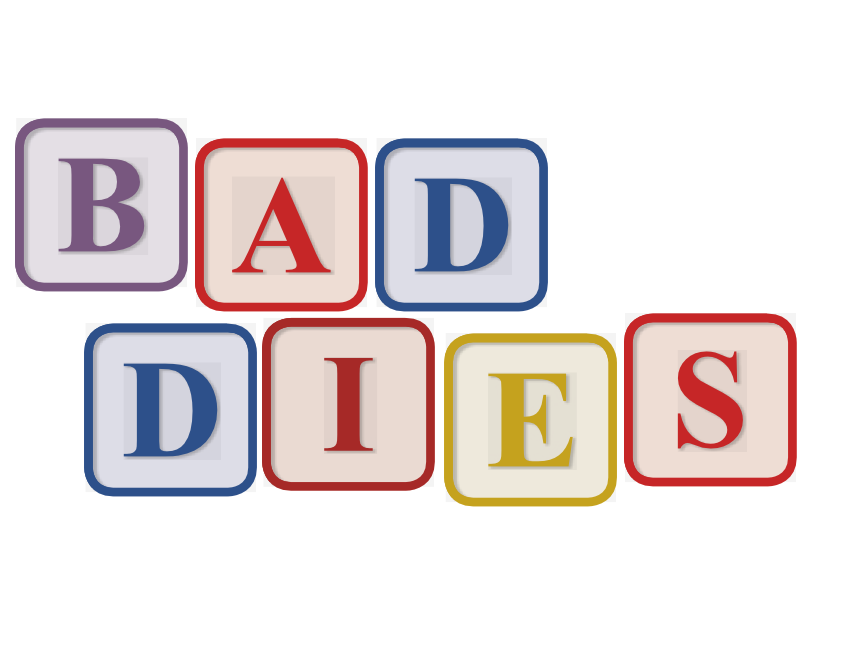by Mayumi-H | Jan 21, 2020 | BonusParts A to Z
BonusParts from A to Z
B: BADDIES
For this entry into the BonusParts A to Z, I’m looking at the Baddies: types, ones I’ve enjoyed, and a few specific examples to hopefully tease some interest.
What’s a Baddie?
Generally speaking, baddies are the bad guys (or gals, or nonbinary individuals) who create conflict within my stories. Not every baddie is evil, though. Sure, some are nefarious villains, but others are simply rivals or foils. They are characters of their own, meaning they can have their own backstory, their own moral code, even their own objective within the story.
The Baddie’s purpose is to offer a point of contrast to the Hero. They are an obstacle to a goal. This can range from a charming challenger for a love interest’s affections to a sadistic crazy person out to destroy all of humanity. It all depends on the story.
She recalled the mysterious stranger in the grimy duster. “Is he a bad guy?”
“‘Bad’ is relative,” the man told her.
“Well, what’s he like?”
“Traitorous, sadistic, egocentric.” He sniffed. “Atrocious table manners.”
A Baddie’s badness level often relates to the overall stakes of the story. Your average Romance probably won’t have a baddie who is a serial killer. By the same token, you wouldn’t expect a Thriller to have a baddie whose primary role was as a romantic rival. I’m not saying you can’t have a serial killer who isn’t also a romantic rival, but the stakes need to add up appropriately for the primary genre you’re writing in.
My Baddies and Me
For a long time, I argued against the necessity of baddies. I thought non-corporeal sources of conflict – societal discrimination, accidents, familial responsibilities – could be enough to propel a story forward. The problem is that conflict against something intangible like social mores or a car accident can only go so far. Instead, these kinds of intangibles initiate reactions in characters that then manifest as more personalized conflicts: the potential lovebirds facing prejudice due to their racial differences. The hero battling his demons of self-doubt. The heroine trying to reconcile her relationships with her traditional family and her nouveau riche boyfriend.
It wasn’t until I looked back on these stories (Sixes and Sevens, Fearless, and 1 More Chance!, respectively) that I realized that a story’s baddies could reside within my goodies. Totally valid, and lots of fun to write. But not as much fun as an actual Baddie.

A Rundown of Recent Baddies
I’m going to highlight some examples of baddies in my novella, Number Seven and the Life Left Behind, which anyone can read if they so choose. [Purchase link; opens in a new tab.] The story’s main protagonist, Number Seven, encounters a few different types of antagonists throughout his adventure:
- Number Fourteen is an adversary to Seven. She does her job, but she does it with cruelty, and she’s got a pretty mean streak. She’s designed to be unlikable.
- Number Twelve is a counterpoint to Seven. He’s a jaded professional who doesn’t really care about anything anymore. I created him to show that Seven’s working world is full of a lot of different people, and not everyone who disagrees with him has been corrupted. Some of them are just tired.
- Number Nine is Seven’s rival, of sorts. She’s as good if not better an agent as he is, though she is portrayed as being more severe. She’s a foil to his endeavors. I wanted her to be a competent but frustrated woman fighting for respect in a predominantly man’s world. Seven doesn’t see her as an enemy except for the situation they’re in, and that’s what really makes her dangerous.
- Number Two is the story’s straight-up villain. He’s Seven’s opposite in nearly every way. He’s vindictive, malicious, manipulative, and pompous, a man who will allow or do anything for sake of the grand plan, no matter who it hurts or how.
Not only did these characters serve separate purposes, they also offered diverse perspectives on the world in which the hero lives. And they were all a sheer delight to write. They are still baddies, though, and do not take the place of the hero. I’m not saying antagonists can’t have their own stories or their own motivations; some of the best are those whose points of view we can understand. But your story’s baddie is not the same as your story’s hero. Otherwise, it would be a different story.
Do you like writing Baddies? What kinds of Baddies do you prefer to write or to read? Let me know in the comments!
by Mayumi-H | Jun 13, 2019 | Number Seven

The quote above was originally submitted for a #1LineWed offering on June 13, 2018. It comes from my original character Darya in “Number Seven and the Life Left Behind” and it gave me trouble in every single edit of the story. Every character needs their own conflict, and I wanted to give her one that was separate – and more personal – from what we witness through Number Seven’s eyes.
The backstory tidbit quoted here popped into my head in the first draft and went through surprisingly few changes before the final version. What bothers me to this day isn’t that I wrote it or that I kept it in the published novella, but whether readers understand what I was going for.
Darya’s Backstory
Darya Vikhrova is the only daughter of Ana Vikhrova, a cosmetics industry star and nouveau riche socialite. Darya’s father is unknown to her. Darya grew up amid material wealth but emotional poverty; Ana consistently told her she wasn’t worth a damn and no one would ever want her outside of her inheritance. As a little girl, Darya was withdrawn, fearful, and prone to private outbursts of anger. During a trip to Italy when she was 9 years old, Darya performed a near-perfect dive from a cliff. It changed her life. Ana’s boyfriend at the time, recognizing the feat, suggested Ana send her daughter to a professional coach. Ana and Darya were both only too happy to agree. Soon after, Darya earned a place on the national junior division team and started winning. Most importantly, she left her mother behind. Eventually, Darya would meet Kirill Morozov and his bodyguard Number Seven, and her life would change again.
In the Novella
I still don’t know if Darya’s story progression comes completely clear in the final version of “Number Seven and the Life Left Behind.” I left out a lot of the details listed above, leaving only a few lines devoted to her history, with most of them expressed by other characters, but I just didn’t want to delve too far into her backstory. She’s a secondary character at best and describing her motivations would have slowed down the main story. Still, I liked what she brought to the final product, and she was certainly fun to write! If I ever return to the world of Number Seven and his friends, I know exactly where Darya’s life will take her next.
by Mayumi-H | Jan 23, 2019 | Other Stories, Process
World Building in Fan Fiction
I enjoyed the first Pacific Rim film. Watching it, I wanted to learn more about that world. For that, I did a little bit of reading and poking around the Internet (mainly the Wikipedia article). While that gave me a gleaning of information, I wanted to do something a little bit more.
I didn’t always like world building. It seemed tedious. But as I’ve started to create my own worlds, I’ve come to appreciate the craft of others’ worlds. It’s just that some worlds lack the specific piece I’m looking for, which is why I write fan fiction.
In the first Pacific Rim movie, I loved the design of Cherno Alpha, the Russian robotic monster-hunter Jaeger. Cherno’s pilots had a great fight scene but were handed a raw deal in the script (along with the Wei triplets and their Crimson Typhoon Jaeger, which had to be one of the coolest ideas for a robot ever). I was in the shower one morning when I got the main ideas for the Kluge twins, competitive brothers caught in the swirl of war with the Kaiju but somehow still distanced from it…until it becomes personal to one of them.
I wrote a drabble based on this personal connection (“Worth Dying For”), but here’s the backstory for the brothers, written in a world-building buzz of one sitting almost 5 years ago…
The Brothers Kluge
Ein and Albert Kluge are fraternal twins from Ulm, a city in Baden-Württemberg in Germany, born September 23, 2000, to parents Inge and Erhard Kluge, a chief engineer at Zwick Roell Group. Brash and competitive, especially with each other, the twin boys grew to adulthood in the far-reaching shadow of Kaiju attacks, each one always trying to one-up his brother for skills and smarts. Their father desired them to stay in Germany and continue their work with him at Zwick, but when they came of age, they enrolled in the Pan Pacific Defense Corps Jaeger Academy. They believed their close genetic bond would make them excellent candidates for the Ranger pilot program (q.v., Gage twins, Wei triplets). However, while their mental and physical scores were significant, they failed out in first cut, being particularly incapable of successful Drifting with one another or anyone else.
Morally winded, the Kluge twins resigned themselves to returning to Germany and their “disappointingly conventional” heritage as material testers like their father. Before they were dismissed from Kodiak Island, though, first-generation Ranger and instructor Stacker Pentecost suggested that, while their competitive nature with each other would prove disastrous in a Conn-Pod, it could be highly beneficial in a research capacity:
“It’s not all about piloting Jaegers, you know,” Pentecost said. “J-Tech Engineering needs checks and balances, too.”
Ein looked at his younger brother. Albert looked back at him with the gleam of a new grin. They turned to Pentecost at the same time, and at the same time said, “When do we start?”
Having agreed to training and assignment at the Vladivostok Shatterdome, the Kluge twins soon became Jaeger Engineers. They contributed to upgrades in design and armor on Jaegers Nova Hyperion and Cherno Alpha. During their assignment at Vladivostok, Ein developed one-sided and mostly-hidden romantic feelings for Ranger Sasha Kaidanovsky, one of the pilots of Cherno Alpha. Albert advised his brother to steer clear of both Sasha and her husband Aleksis, but Ein remained devoted:
“You’re a fool if you think you have any chance with Frau Kaidonovsky,” Albert said, snorting under his breath.
Ein wilted. “I know she will never be mine. But I cannot ignore that which beats in my heart. So I will do everything in my power to help her. With or without you, Brüderchen.”
When the Vladivostok Shatterdome was closed in 2024, Cherno Alpha and her J-Tech team, including the Kluge twins, were relocated to Hong Kong. On 8 January 2025, Hermann Gottlieb’s predicted Double Event occurred. Kaiju Leatherback and Otachi attacked, destroying the Jaegers Crimson Typhoon and Cherno Alpha.
On hearing the news of the Kaidanovskys’ deaths, Ein Kluge was never the same. Neither was his brother Albert.
by Mayumi-H | Sep 20, 2016 | Fearless
One of my recent Timehop memories was a
#TBT /
#ThrowBackThursday to my very first 100 Word Challenge for Grown-Ups, from February 2012. At the time, I was deeply entrenched in writing the first draft of “Fearless,” which remains one of my hope-for novels. (It’s currently in draft 2.5, for anyone wondering.) That long-ago 100-word entry was titled
“Everyone Loves Neville,” and, if you’re interested, you can see the original at the link. That first writing challenge started me on a path of picking up more over the years. Through those challenges, I learned a lot about the value of words.
There’s a lot in that first foray that I like. There’s also room for improvement. Here’s a second take on that effort, hopefully for the better:
The girl lingered beside him, her chest heaving even though they’d been out of the water for ten minutes. “Thanks for the lesson, Nev.” Her wet lashes flickered at him. “If there’s ever anything I can do…?”
“Just practise,” Nev said, before sending her on her way.
Ross sidled to his shoulder, to stare after the girl swaying up the shore. “You lucky bastard. Everyone loves you!”
Nev looked at him: his friend with the wide, luscious smile and eyes so deep and blue he often dreamt of drowning in them. He sniffed and picked up his board. “Not everyone.”
I tried to set myself to a 100-word story-a-day challenge this past May, but it didn’t pan out. I did manage a few short vignettes which ended up being pretty good, but the lack of readers and feedback quickly deflated my excitement.
There wasn’t much reason to go back and “fix” this bit of short challenge writing, except that Ross, Nev, and the others have been on my mind again, of late, and that Timehop reminder of my first 100WCGU challenge prompted me to revisit sweet, lovestruck Nev. Of course, I can never stop at rewriting just one thing. As it so goes, I’ve also been working on rewrites for lots of my “Finding Mister Wright” short stories (including the one I just sent in for 4amwriter’s Dare to Write summer challenge!), and Highs, Lows, and In-Betweens, the big sci-fi/action team novel from 2014’s NaNoWriMo. But, that’s an update for another day….
Who else out there remembers the 100WCGU challenges? Have you ever challenged yourself with a writing-limit goal? Working on any interesting rewrites, lately? Let me know in the comments! I’d love to know I’m not doing this alone. 🙂
by Mayumi-H | Nov 7, 2015 | Persona 4 Fan Fiction, Process
Sometimes, separating the writer from the character is hard. We find ourselves putting our own traits into those of our protagonist, so they become mirrors of us. They may share the same taste in music, food, or hobbies. Their favorite sports team may be ours; that song on the radio we just can’t stand may make them grind their teeth, too.
One trait that I’ve noticed that comes through in all of my favorite characters is an interest in cooking. Their proficiency levels vary (from Chie’s ignorance about what “simmer” means, to Marshall knowing the recipe for drop scones so well he can make them in his brother’s kitchen without a book), but they always enjoy cooking. It may have different meanings for them – a desire to please, a need to control, sometimes just a way for characters to relax or get to know each other better – but even those meanings are from my own experience.
Even though I’m not actively writing while I do it, cooking allows me the freedom to let my mind wander. It’s a time of day I usually spend alone with my thoughts, and those thoughts almost invariably turn to my stories and characters: Does Paige sneak chopped vegetables from the cutting board while Daniel looks away? Does Ross sway with Amber as she stirs some sauce? Does Axton have to stop making breakfast because the hounds won’t settle down?
No matter who the character is – doctor, dancer, reckless bounty hunter – they’re all me, in a way. I’m no doctor; I’m barely a dancer; I couldn’t track a skip to save my life. But there are more basic traits we share between us, like joy for art, work, and – sure – cooking. In honor of that sense of sharing, I thought I’d share a bit of a recent cooking experience: curried shrimp and mango soup. The photos below detail the real-life steps I took, but rest assured as ingredients were browning, bubbling, and coming together in that Dutch oven, my brain was equally bubbling with ideas for where my next story should go. And, of course, there’ll be cooking.
If you’re interested, here’s the recipe, originally from Eating Well:
Ingredients
- 1 tablespoon extra-virgin olive oil
- 1 large onion, chopped
- 2 stalks celery, sliced
- 4 cloves garlic, chopped
- 1 serrano chile, minced (optional)
- 2 tablespoons curry powder
- 1 teaspoon dried thyme
- 2 cups seafood broth or stock or clam juice
- 1 14-ounce can “lite” coconut milk
- 3 ripe mangoes, diced
- 1 1/4 pounds raw shrimp, peeled and deveined
- 1 bunch scallions, sliced
- 1/4 teaspoon salt
Preparation
- Heat oil in a Dutch oven over medium heat. Add onion and celery and cook, stirring occasionally, until beginning to brown, 3 to 5 minutes. Add garlic, chile (if using), curry powder and thyme; stir constantly for 30 seconds. Add broth (or stock or clam juice), coconut milk and mangoes. Bring to a simmer over medium-high heat. Reduce heat to maintain a simmer and cook, stirring occasionally, for 5 minutes.
- Puree 3 cups of the soup in a blender. (Use caution when pureeing hot liquids.) Return the puree to the pot and bring to a simmer. Add shrimp and cook until pink and firm, about 3 minutes. Stir in scallions and salt.
What personal traits – if any – do you find you share most commonly with your characters? What do you see your characters doing when you’re cooking, doing the wash, or some other regular chore? Do you think you’ll try the curried shrimp and mango soup recipe? Let me know in the comments!




Recent Comments
The Real Person!
Author Mayumi-H acts as a real person and passed all tests against spambots. Anti-Spam by CleanTalk.
The Real Person!
Author Mayumi-H acts as a real person and passed all tests against spambots. Anti-Spam by CleanTalk.